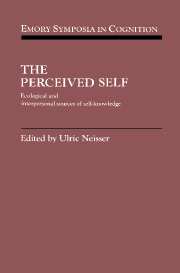Book contents
- Frontmatter
- Contents
- Preface
- List of contributors
- Part I Introduction
- Part II The concept of an ecological self
- 2 Ontogenesis of the perceived self
- 3 Body–environment coupling
- 4 A theory of representation-driven actions
- 5 The ecological self in historical context
- 6 Good intentions and dancing moments: Agency, freedom, and self-knowledge in dance
- 7 The primacy of the ecological self
- Part III The interpersonal self and its implications
- Author index
- Subject index
6 - Good intentions and dancing moments: Agency, freedom, and self-knowledge in dance
Published online by Cambridge University Press: 29 March 2010
- Frontmatter
- Contents
- Preface
- List of contributors
- Part I Introduction
- Part II The concept of an ecological self
- 2 Ontogenesis of the perceived self
- 3 Body–environment coupling
- 4 A theory of representation-driven actions
- 5 The ecological self in historical context
- 6 Good intentions and dancing moments: Agency, freedom, and self-knowledge in dance
- 7 The primacy of the ecological self
- Part III The interpersonal self and its implications
- Author index
- Subject index
Summary
The title of this chapter may seem like an assemblage of disparate terms, but I hope to show that they are all interrelated. My method of analysis is phenomenological – that is, it seeks to unravel the structure and values of a phenomenon, in this case, self-knowledge in dance, through reductive analysis. In order to avoid being sidetracked with an explanation of phenomenology, I will simply say that phenomenology is a descriptive method; it is also philosophical. Once embarked upon a phenomenological description, one is obligated to pursue the essence of the phenomenon, the thing in itself. Phenomenology aims to describe and define through a distillation of consciousness. In this sense, it is reductive. In focusing on self-knowledge in terms of dance, agency and freedom arise as important experiential values. They are intrinsic values in dance, aspects of the dancer's knowledge of, or perception of, self. Agency and freedom are interrelated aspects of dancing moments (those times when our intentions are realized in dance), and dancing moments are the basis for self-knowledge in dance. I will utilize the psychological concept of the “ecological self,” from Ulric Neisser, the self directly perceived as it moves through, acts upon, and experiences its immediate environment.
- Type
- Chapter
- Information
- The Perceived SelfEcological and Interpersonal Sources of Self Knowledge, pp. 102 - 111Publisher: Cambridge University PressPrint publication year: 1994
- 17
- Cited by



